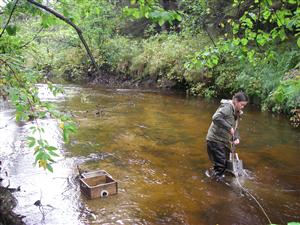Sediment Quality Indicators: Chemical Indicators
The concentration of chemicals adsorbed to sediments—generally measured in units of mg chemical/kg sediment—affects the quality of habitat for sediment-dwelling organisms, which live in contact with the sediments and may ingest sediment particles. Chemicals adsorbed to sediments can also re-enter the water column depending on environmental conditions such as dissolved oxygen concentrations, pH, and temperature. The chemical characteristics of sediment depend on the natural geology of the basin and erosional processes that transport minerals into the waterbody, as well as human activities that cause pollution to enter the river system.
Chemical indicators commonly measured in sediments include:
Metals. Sediment metal content reflects the composition of parent minerals as well as inputs to the river system. Metals vary in their ability to adsorb to mineral particles and organic matter within the sediments.
Hydrocarbons. Concentrations of hydrocarbons in sediment can be measured on the basis of size (e.g., number of carbon atoms) or by compound type. Polycyclic aromatic hydrocarbons (PAHs) are compounds associated with fossil fuel deposits such as bitumen and with combustion and decay of organic compounds, and are of concern due to their toxicity to aquatic organisms and humans. Certain PAH compounds are indicative of specific sources; for example, dibenzothiophene molecules are associated with bitumen, while retene is generated through the decomposition of plant materials (RAMP 2005).
Toxicity. Toxicity assessments are conducted on the entire sediment assemblage, including the sediment substrate and associated chemicals. Toxicity measurements account for additive or synergistic effects of the different chemicals within the sediment sample, rather than assessing the toxicity of individual chemicals. Assessments of acute toxicity measure the survival of indicator aquatic species after a certain number of days of exposure to the sediment sample. Chronic toxicity assessments examine the effect of the sediments on biological processes such as growth or reproduction.









